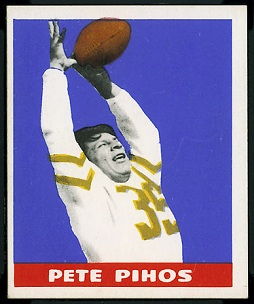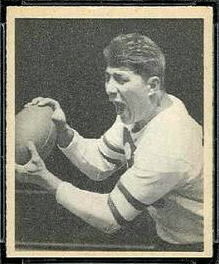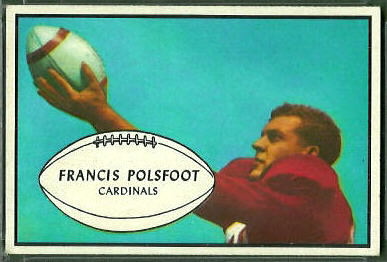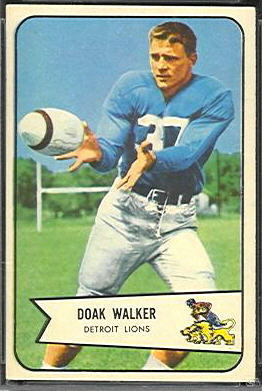The Leaf Gum Company printed football cards in 1948 and 1949. The cards from the two years are very similar. In fact, except for the variations in the 1948 cards, for players who appear in both sets, the fronts of the cards appear identical. The backs are different for the two years, fortunately, and the copyright date on the bottom of the back tells which year a card is from. Shown here are Leaf’s two Herb Seigert cards, the first from 1948, and the second from 1949.
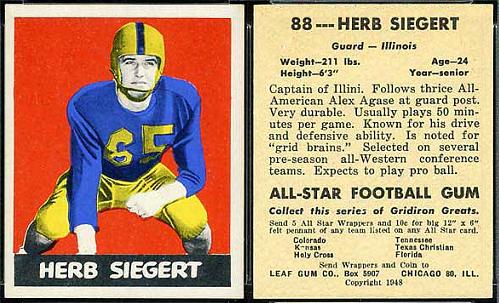
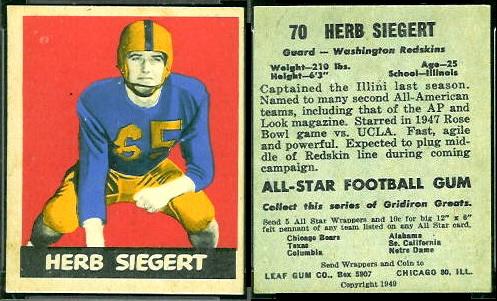
The images on the Leaf cards started as black and white photos, and then someone colored the images’ backgrounds and the players’ uniforms. On some cards, such as the Harry Szulborski card below, the coloring makes it look as if the player’s head was cut out and pasted on a colored background.
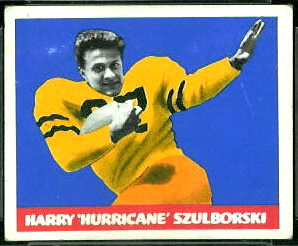 My favorite feature of the Leaf cards is that many have both the player’s first name and nickname on the front: ‘Slingin’ Sammy Baugh, ‘Bullet’ Bill Dudley, Charlie ‘Choo Choo’ Justice, and so on. A quick bit of trivia: which player’s nickname is in double quotes? Answer: Clyde “Bulldog” Turner‘s.
My favorite feature of the Leaf cards is that many have both the player’s first name and nickname on the front: ‘Slingin’ Sammy Baugh, ‘Bullet’ Bill Dudley, Charlie ‘Choo Choo’ Justice, and so on. A quick bit of trivia: which player’s nickname is in double quotes? Answer: Clyde “Bulldog” Turner‘s.
The 1948 Leaf set consists of 98 cards, with cards 1-49 being easier to find and cards 50-98 being difficult. The set features both pro and college players, with slightly more than half of the cards being pros. The bigger stars of the day–mostly pros–are concentrated in the first half of the set, and most of the college players are in the second half.
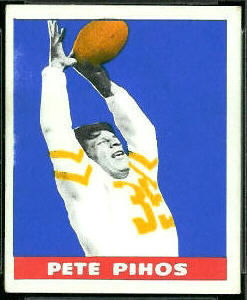
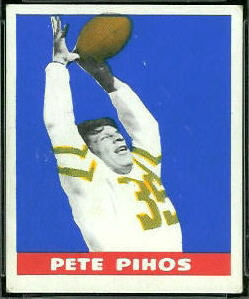 The set contains many variations: mostly in the colors used, but in the players’ names as well. The 1948 Leaf set composition page on PSA’s web site lists most of the variations, but I don’t believe it is complete. It lists two variations of the Pete Pihos rookie card, for example, one with yellow numbers and one with blue. I have also seen a variation with greenish numbers, though. It is pictured here with the yellow-numbered version for contrast.
The set contains many variations: mostly in the colors used, but in the players’ names as well. The 1948 Leaf set composition page on PSA’s web site lists most of the variations, but I don’t believe it is complete. It lists two variations of the Pete Pihos rookie card, for example, one with yellow numbers and one with blue. I have also seen a variation with greenish numbers, though. It is pictured here with the yellow-numbered version for contrast.
Because there had been no major football card issues since 1935 National Chicle, all of the 1948 Leaf football cards are rookie cards. Fourteen of the players in the set are of Hall of Famers, making it a key set for Hall of Fame rookie card collectors. Fortunately for those collectors, only two of the Hall of Fame players–namely Leo Nomellini and Chuck Bednarik–are in the tougher second half of the set. (Nomellini and Bednarik were both still in college at the time.) An article by Kevin Glew on the Collectors Universe web site lists the Hall of Famers and describes the other challenges facing 1948 Leaf collectors.
Compared to the 1948 Leaf set, the 1949 Leafs are not very interesting. The 1949 set contains only 49 cards, all pro players, and there are no new players in the set. Also, as I wrote above, there is no perceptible difference in the card fronts for players who appear in both sets. So Leaf’s 1949 offer was essentially half of 1948’s cards, but with different backs.
One odd thing about the 1949 set is that it is skip-numbered, with the numbers of its 49 cards scattered between 1 and 150. When I first learned this, I wondered if Leaf had intended to release more cards to fill in the gaps. It turns out, though, that they also skip-numbered their 1949 baseball set. That suggests to me that they were trying to trick kids into buying more cards, even if they already had the whole set. I’d call that just plain mean. It’s not surprising that this was Leaf’s last football set.
You can see all of the 1948 Leaf and 1949 Leaf cards in the Vintage Football Card Gallery.
